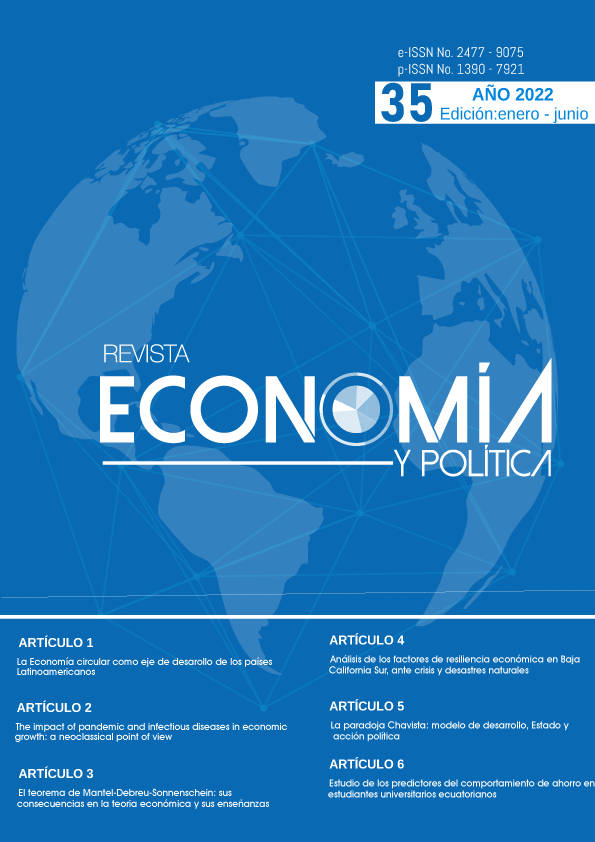The impact of pandemic and infectious diseases in economic growth: A neoclassical point of view
DOI:
https://doi.org/10.25097/rep.n35.2022.02Keywords:
Pandemic, Economic Growth, Richard Function, Poverty TrapsAbstract
We develop a neoclassical growth model introducing a Richard production function to describe the shock of pandemic and infectious diseases affecting the supply side. The model shows that in proportion of exogenous shock, countries with low level technologies in the productive sectors reduce the labor productivity and under some conditions may fall in a poverty trap. Whereas countries with high level technology also reduce the labor productivity but has faster recovery. We show that the incorporation of modern technology and improvements in human capital are necessary conditions to overcome the poverty trap.
Downloads
References
Accinelli, E., Brida, J. G. (2007). The dynamics of the Ramsey economic growth model with the von Bertalanffy population growth law. Applied Mathematical Sciences, Vol. 1(No. 2), pp. 109–118.
Acemoglu, D. (2002). Technical change, inequality, and the labor market. Journal of Economic Literature, Vol. 40(No. 1), pp. 7- 72.
Acemoglu, D., Johnson, S. (2007). Disease and development: The effect of life expectancy on growth. Journal of Political Economy, Vol. 115(No. 6), pp. 925-985.
Acemoglu, D., Zilibotti, F. (2001). Productivity differences. The Quarterly Journal of Economics, Vol. 116(No. 2), pp. 563–606.
Agénor, P. (2015). Public capital, health persistence and poverty traps. Journal of Economics, Vol. 115, pp. 103–131.
Azariadis, C. (2006). The Theory of Poverty Traps, what have we learned? In S. Bowles (Ed.), Poverty traps (pp. 19–40). Pricenton University Press.
Azariadis, C., Drazen, A. (1990). Threshold Externalities in Eco- nomic Development. The Quarterly Journal of Economics, Vol. 105(No. 2), pp. 501–526.
Azariadis, C., Stachurski, J. (2005). Poverty Traps. In P. Aghion S. Durlauf (Eds.), Handbook of economic growth (Vol. 1A, pp. pp. 295–384). Elsevier.
Bell, D., Blanchflower, D. (2020). US and UK labor markets before and during the covid-19 crash. National Institute Economic Review, Vol. 252, pp. R52-R69.
Bick, A., Blandin, A. (2020, January). Real-time labor market estimates during the 2020 coronavirus outbreak. SSRN Electronic Journal.
Biddle, J. (2014). The cyclical behavior of labor productivity and the emergence of the labor hoarding concept. Journal of Economic Perspectives, Vol. 28 (No. 2), pp. 197-212.
Brida, J. G. (2008). Población y crecimiento económico una versión mejorada del modelo de Solow. El Trimestre Económico, Vol. 75, pp. 5-22.
Chou, J., Kuo, N., Peng, S. (2004). Potential impacts of the Sars outbreak on Taiwan’s economy. Asian Economic Papers, Vol. 3(No. 1), pp. 84-99.
Coibion, O., Gorodnichenko, Y., Weber, M. (2020). The cost of the covid-19 crisis: Lockdowns, macroeconomic expectations, and consumer spending (Working Paper Series No. 27141). National Bureau of Economic Research.
Dossche, M., Gazzani, A., Lewis, V. (2021). Labor adjustment and productivity in the OECD (Working Paper Series No. 2571). European Central Bank.
Englmann, F. (1994). A Schumpeterian model of endogenous in- novation and growth. Journal of Evolutionary Economics, Vol. 4(No. 3), pp 227-241.
Fermand, J., Wang, J. (2016). Why has the cyclicality of productiv ity changed? what does it mean? Annual Review of Economics, Vol. 8(No. 1), pp. 465-496.
Ferrara, M., Guerrini, L. (2009). The Ramsey model with logistic population growth and Benthamite felicity function revisited. WSEAS Transactions on Mathematics, Vol. 8(No. 3), pp. 97– 106.
Foster, J., Wild, P. (1999). Econometric modelling in the presence of evolutionary change. Cambridge Journal of Economics, Vol. 23(No. 6), pp. 749-770.
Goenka, A., Liu, L. (2020). Infectious diseases, human capital and economic growth. Economic Theory, Vol. 70, pp. 1–47.
Guerrini, L. (2006). The Solow-Swan model with a bounded population growth rate. Journal of Mathematical Economics, Vol. 42(No. 1), pp. 14–21.
Guerrini, L. (2010). A closed-form solution to the Ramsey model with logistic population growth. Economic Modelling, Vol. 27(No. 5), pp. 1178–1182.
Hai, W., Zhao, Z., Wang, J., Hou, Z. (2004). The short-term impact of Sars on the chinese economy. Asian Economic Papers, Vol. 3(No. 1), pp. 57-61.
Inada, K. (1963). On a Two-Sector Model of Economic Growth: Comments and a Generalization. The Review of Economic Stud ies, Vol. 30(No. 2), pp. 119-127.
Lucas, R. E. (1988). On the mechanics of economic development. Journal of Monetary Economics, Vol. 22, pp. 3–42.
Plata, L., González, P., Calderón, E. (2017). La función de crecimiento de Richard y los modelos de crecimiento neoclásicos. EconoQuantum, Vol. 14 (Num. 1), pp. 99-118.
Reati, A. (1998). Technological revolutions in Pasinetti’s model of structural change: productivity and prices. Structural Change and Economic Dynamics, Vol. 9 (No. 2), Pages 245–262.
Richard, F. (1959). A flexible growth function for empirical use. Journal of Experimental Botany, Vol. 10 (No. 29), pp. 290-300.
Romer, P. (1986). Increasing returns and long-run growth. Journal of Political Economy, Vol. 94 (No. 5), pp. 1002-1037.
Sachs, J., McArthur, J., Schmidt-Traub, G., Kruk, M., Bahadur, C., Faye, M., McCord, G. (2004). Ending Africa’s poverty trap. Brookings Papers on Economic Activity (No. 1), pp. 117-240.
Scarpello, G., Ritelli, D. (2003). The Solow model improved through the logistic manpower growth law. Annali dell’Universita di Ferrara, Vol. 49 (No. 1), pp. 73-83.
Siu, A., Wong, R. (2004). Economic impact of Sars: The case of Hong Kong. Asian Economic Papers, Vol. 3(No. 1), pp. 62-83.
Solow, R. (1964). Draft of presidential address on the short run relation of employment and output. In D. Rubenstein (Ed.), Robert Solow papers. Box 70, Dated 1964.
Wray, L. R. (1991). Saving, profits, and speculation in capitalist economies. Journal of Economic Issues, Vol. 25(No. 4), pp. 951-975.
Published
How to Cite
Issue
Section
License
Copyright (c) 2022 Economy and Politics Journal

This work is licensed under a Creative Commons Attribution-NonCommercial-ShareAlike 4.0 International License.
The Journal declines any responsibility for possible conflicts derived from the authorship of the works that are published in it.
The University of Cuenca in Ecuador conserves the patrimonial rights (copyright) of the published works and will favor the reuse of the same ones, these can be: copy, use, diffuse, transmit and expose publicly.
Unless otherwise indicated, all contents of the electronic edition are distributed under a Creative Commons Attribution-NonCommercial-ShareAlike 4.0 International License.







